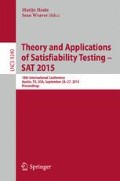Abstract
The way CDCL SAT solvers find a satisfying assignment is very different from the way they prove unsatisfiability. We propose an explanation to the difference by identifying direct connections to the workings of some of the most important elements in CDCL solvers: the effects of restarts and VSIDS, and the roles of learned clauses. We give a wide range of concrete evidence that highlights the varying effects and roles of these elements. As a result, this paper also sheds a new light on the internal workings of CDCL. Based on our reasoning on the difference in solver behaviors, we present several ideas for optimizing SAT solvers for either SAT or UNSAT instances. We then show that we can achieve improvements on both SAT and UNSAT at the same time by judiciously exploiting the difference. We have implemented a hybrid idea mixing two different restart strategies on top of our new solver COMiniSatPS and observed substantial performance improvement.
Access this chapter
Tax calculation will be finalised at checkout
Purchases are for personal use only
Preview
Unable to display preview. Download preview PDF.
References
Aigner, M., Biere, A., Kirsch, C.M., Niemetz, A., Preiner, M.: Analysis of portfolio-style parallel SAT solving on current multi-core architectures. In: POS (2013)
Alfonso, E.M., Manthey, N.: Riss 4.27 BlackBox. In: SAT-COMP (2014)
Audemard, G., Lagniez, J.-M., Mazure, B., Saïs, L.: On freezing and reactivating learnt clauses. In: Sakallah, K.A., Simon, L. (eds.) SAT 2011. LNCS, vol. 6695, pp. 188–200. Springer, Heidelberg (2011)
Audemard, G., Simon, L.: Predicting learnt clauses quality in modern SAT solvers. In: IJCAI (2009)
Audemard, G., Simon, L.: Glucose 2.1: aggressive but reactive clause database management, dynamic restarts. In: POS (2012)
Audemard, G., Simon, L.: Refining restarts strategies for SAT and UNSAT. In: Milano, M. (ed.) CP 2012. LNCS, vol. 7514, pp. 118–126. Springer, Heidelberg (2012)
Biere, A.: Adaptive restart strategies for conflict driven SAT solvers. In: Kleine Büning, H., Zhao, X. (eds.) SAT 2008. LNCS, vol. 4996, pp. 28–33. Springer, Heidelberg (2008)
Biere, A.: Lingeling, plingeling and treengeling entering the SAT competition 2013. In: SAT-COMP (2013)
Biere, A.: Yet another local search solver and lingeling and friends entering the SAT competition 2014. In: SAT-COMP (2014)
Chen, J.: Solvers with a bit-encoding phase selection policy and a decision-depth-sensitive restart policy. In: SAT-COMP (2013)
Chen, J.: Minisat\(\_\)blbd. In: SAT-COMP (2014)
Dubois, O., Andre, P., Boufkhad, Y., Carlier, J.: SAT versus UNSAT. In: DIMACS Cliques, Coloring and Satisfiability (1996)
Eén, N., Sörensson, N.: An extensible SAT-solver. In: Giunchiglia, E., Tacchella, A. (eds.) SAT 2003. LNCS, vol. 2919, pp. 502–518. Springer, Heidelberg (2004)
Gelder, A.V.: Contrasat - A contrarian SAT solver. JSAT (2012)
Gomes, C.P., Selman, B., Crato, N., Kautz, H.A.: Heavy-tailed phenomena in satisfiability and constraint satisfaction problems. J. Autom. Reasoning (2000)
van der Grinten, A., Wotzlaw, A., Speckenmeyer, E., Porschen, S.: SATUZK: solver description. In: SAT-COMP (2013)
Haim, S., Heule, M.: Towards ultra rapid restarts. CoRR (2014)
Haken, A.: The intractability of resolution. Theor. Comput. Sci. (1985)
Huang, J.: The effect of restarts on the efficiency of clause learning. In: IJCAI (2007)
Hutter, F., Lindauer, M., Balint, A., Bayless, S., Hoos, H., Leyton-Brown, K.: The Configurable SAT Solver Challenge (CSSC). Under review at AIJ; preprint available on arXiv: (2015). http://arxiv.org/abs/1505.01221
Jabbour, S., Lonlac, J., Sais, L., Salhi, Y.: Revisiting the learned clauses database reduction strategies. CoRR (2014)
Luby, M., Sinclair, A., Zuckerman, D.: Optimal speedup of las vegas algorithms. Inf. Process. Lett. (1993)
Moskewicz, M.W., Madigan, C.F., Zhao, Y., Zhang, L., Malik, S.: Chaff: engineering an efficient SAT solver. In: DAC (2001)
Nossum, V.: SAT-based preimage attacks on SHA-1. Master’s thesis, University of Oslo (2012)
Oh, C.: MiniSat\(\_\)HACK\(\_\)999ED, MiniSat\(\_\)HACK\(\_\)1430ED, and SWDiA5BY. In: SAT-COMP (2014)
Pipatsrisawat, K., Darwiche, A.: A lightweight component caching scheme for satisfiability solvers. In: Marques-Silva, J., Sakallah, K.A. (eds.) SAT 2007. LNCS, vol. 4501, pp. 294–299. Springer, Heidelberg (2007)
Pipatsrisawat, K., Darwiche, A.: On the power of clause-learning SAT solvers as resolution engines. Artif. Intell. (2011)
Ryvchin, V., Strichman, O.: Local restarts. In: Kleine Büning, H., Zhao, X. (eds.) SAT 2008. LNCS, vol. 4996, pp. 271–276. Springer, Heidelberg (2008)
Silva, J.P.M., Sakallah, K.A.: GRASP: A search algorithm for propositional satisfiability. IEEE Trans. Computers (1999)
Simon, L.: Post mortem analysis of SAT solver proofs. In: POS (2014)
Sonobe, T., Inaba, M.: Counter implication restart for parallel SAT solvers. In: Hamadi, Y., Schoenauer, M. (eds.) LION 2012. LNCS, vol. 7219, pp. 485–490. Springer, Heidelberg (2012)
Yasumoto, T.: SINN. In: SC (2012)
Yasumoto, T.: TENN. In: SC (2012)
Yasumoto, T.: ZENN. In: SC (2012)
Yasumoto, T., Okugawa, T.: SINNminisat. In: SAT-COMP (2013)
Yasumoto, T., Okugawa, T.: ROKK. In: SAT-COMP (2014)
Author information
Authors and Affiliations
Corresponding author
Editor information
Editors and Affiliations
Rights and permissions
Copyright information
© 2015 Springer International Publishing Switzerland
About this paper
Cite this paper
Oh, C. (2015). Between SAT and UNSAT: The Fundamental Difference in CDCL SAT. In: Heule, M., Weaver, S. (eds) Theory and Applications of Satisfiability Testing -- SAT 2015. SAT 2015. Lecture Notes in Computer Science(), vol 9340. Springer, Cham. https://doi.org/10.1007/978-3-319-24318-4_23
Download citation
DOI: https://doi.org/10.1007/978-3-319-24318-4_23
Published:
Publisher Name: Springer, Cham
Print ISBN: 978-3-319-24317-7
Online ISBN: 978-3-319-24318-4
eBook Packages: Computer ScienceComputer Science (R0)

